
Saxe-Coburg and Gotha, or Saxe-Coburg-Gotha, was an Ernestine, Thuringian duchy ruled by a branch of the House of Wettin, consisting of territories in the present-day states of Thuringia and Bavaria in Germany. It lasted from 1826 to 1918. In November 1918, Charles Edward, Duke of Saxe-Coburg and Gotha, was forced to abdicate. In 1920, the northern part of the duchy was merged with six other Thuringian free states to form the Free State of Thuringia: Saxe-Weimar-Eisenach, Saxe-Altenburg and Saxe-Meiningen, Schwarzburg-Rudolstadt and Schwarzburg-Sondershausen, as well as the People's State of Reuss. The southern part of the duchy, as southernmost of the Thuringian states, was the only one which, after a referendum, became part of the Free State of Bavaria.
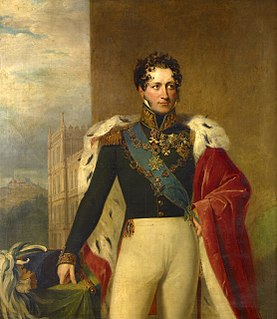
Ernest I was the last sovereign duke of Saxe-Coburg-Saalfeld and, from 1826, the first sovereign duke of Saxe-Coburg and Gotha. He was the father of Albert, Prince Consort, who was the husband of Queen Victoria. Ernest fought against Napoleon Bonaparte, and through construction projects and the establishment of a court theatre, he left a strong imprint on his residence town, Coburg.

Saxe-Coburg was a duchy held by the Ernestine branch of the Wettin dynasty in today's Bavaria, Germany.

DomFerdinand II was a German prince of the House of Saxe-Coburg and Gotha-Koháry, and King of Portugal jure uxoris as the husband of Queen Maria II, from the birth of their first son in 1837 to her death in 1853.
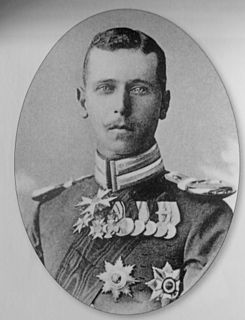
Alfred, Hereditary Prince of Saxe-Coburg and Gotha, was the son and heir apparent of Alfred, Duke of Saxe-Coburg and Gotha. He died aged 24 under circumstances still not entirely clear. He was a first cousin of Kaiser Wilhelm II of Germany, King George V of the United Kingdom and Tsar Nicholas II of Russia.

The House of Saxe-Coburg and Gotha is a European Royal House. It takes its name from its oldest domain, the Ernestine duchy of Saxe-Coburg and Gotha, its members later sat on the thrones of Belgium, Bulgaria, Mexico, Portugal, and the United Kingdom and its dominions.

Saxe-Coburg-Saalfeld was one of the Saxon Duchies held by the Ernestine line of the Wettin Dynasty. Established in 1699, the Saxe-Coburg-Saalfield line lasted until the reshuffle of the Ernestine territories that occurred following the extinction of the Saxe-Gotha line in 1825, in which the Saxe-Coburg-Saalfeld line received Gotha, but lost Saalfeld to Saxe-Meiningen.

Reinhardsbrunn in Friedrichroda near Gotha, in the German state of Thuringia, is the site of a formerly prominent Benedictine abbey, the house monastery of the Ludovingian Landgraves of Thuringia abbey extant between 1085 and 1525. Later used as an administrative seat by the Ernestine dukes of Saxony, the premises were turned into a castle and park erected by the Dukes of Saxe-Coburg and Gotha from 1827.

Prince Ferdinand Georg August of Saxe-Coburg and Gotha was a German prince of the House of Saxe-Coburg and Gotha and a general of cavalry in the Austrian Imperial and Royal Army during the Napoleonic Wars. Despite remaining a Lutheran, by marriage he established the Catholic branch of the family, which eventually gained the thrones of Portugal (1837) and Bulgaria (1887).

August Victor Louis of Saxe-Coburg and Gotha, was a German prince of the Catholic House of Saxe-Coburg and Gotha-Koháry. He was a General Major in the Royal Saxon Army and the owner of Čábráď and Štiavnica, both in modern-day Slovakia.

Ferdinand Philipp Maria August Raphael of Saxe-Coburg and Gotha was the second prince of Saxe-Coburg and Gotha and lord of Csábrág and Szitnya, both in modern-day Slovakia.

Prince Ludwig Gaston of Saxe-Coburg and Gotha, known in Brazil as Dom Luís Gastão, was a German prince of the House of Saxe-Coburg and Gotha-Koháry, and the last surviving grandchild of Emperor Pedro II of Brazil.
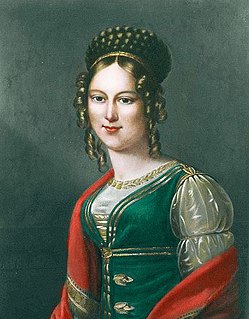
Princess Mária Antónia von Koháry was a Hungarian noblewoman and the ancestor of several European monarchs. She was the sole heiress of the House of Koháry, which belonged to one of the three largest landowners in Hungary.

Duchess Marie of Württemberg was a daughter of Duke Alexander of Württemberg and Antoinette of Saxe-Coburg-Saalfeld. She was Duchess of Saxe-Coburg and Gotha from 1832 to 1844 as the second wife of Duke Ernest I. As such, she was the stepmother of Prince Albert, consort of Queen Victoria.

Elisabeth of the Palatinate was the second wife of John Frederick II, Duke of Saxony.
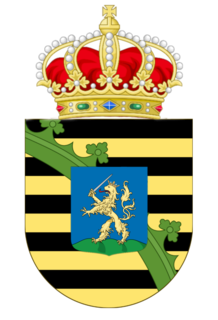
The House of Saxe-Coburg and Gotha-Koháry is the Catholic cadet branch of the House of Saxe-Coburg and Gotha, founded after the marriage of Prince Ferdinand of Saxe-Coburg and Gotha and Princess Maria Antonia Koháry de Csábrág. Among its descendants were the last four kings of Portugal and the last three Tsars of Bulgaria. After the change of the “House laws” by King Simeon, the present head of the house is his sister Princess Marie Louise of Bulgaria, Princess of Koháry.
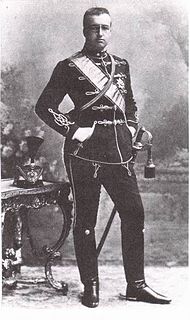
Prince Leopold Clement Philipp August Maria of Saxe-Coburg and Gotha was an Austro-Hungarian officer and the heir apparent to the wealth of the House of Koháry. His death in a murder–suicide shocked the royal courts of Austria and Germany.
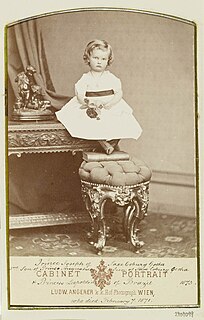
Prince Joseph Ferdinand of Saxe-Coburg and Gotha, known in Brazil as Dom José Fernando, was a prince of the House of Saxe-Coburg and Gotha-Koháry. Born in Leopoldina Palace, Rio de Janeiro, he was the third son of Prince Ludwig August of Saxe-Coburg and Gotha and his wife Princess Leopoldina of Brazil. He died of pneumonia at the age of 19 in Wiener Neustadt and is buried at St. Augustin, Coburg.

Callenberg Castle is a castle on a wooded hill in Beiersdorf, an Ortsteil of Coburg, 6 kilometres (3.7 mi) from the town centre. It was a hunting lodge and summer residence and has long been the principal residence of the House of Saxe-Coburg and Gotha. It is currently owned by Andreas, Prince of Saxe-Coburg and Gotha who created the Ducal Saxe-Coburg and Gotha House Order. A large and architecturally important family chapel is contained within.
Prince Philipp of Saxe-Coburg and Gotha was a dynast of the House of Wettin, belonging to the House of Saxe-Coburg and Gotha-Koháry. He was the last Fideikommissherr of the branch.




















